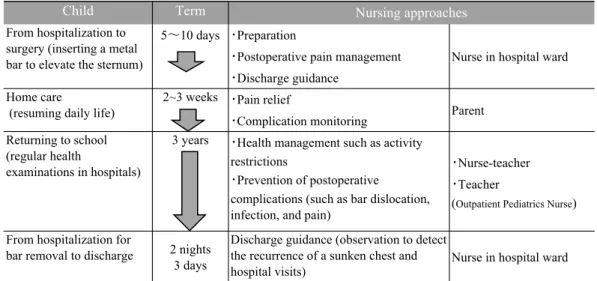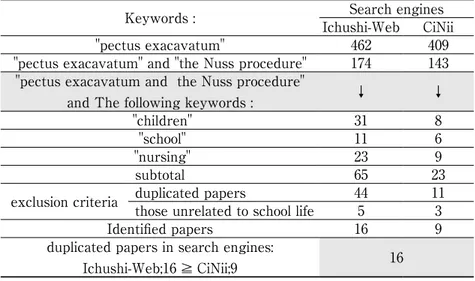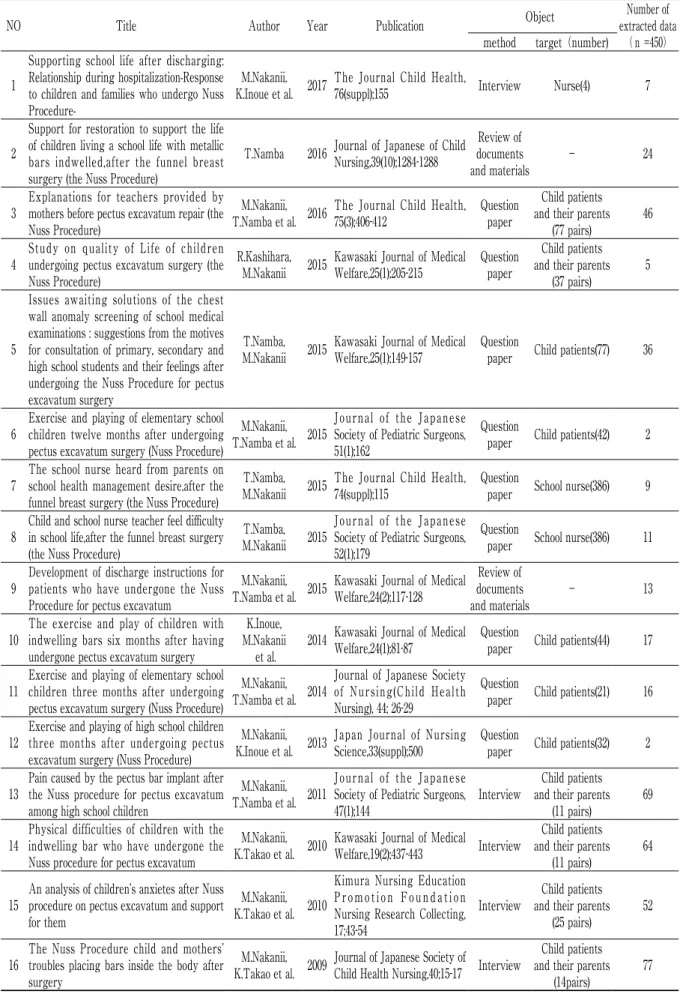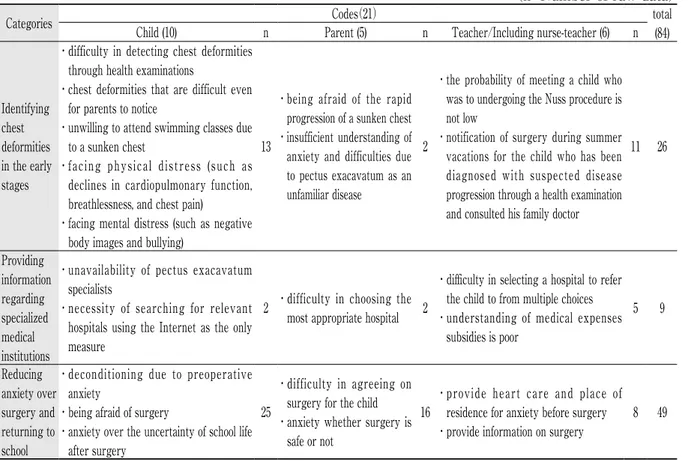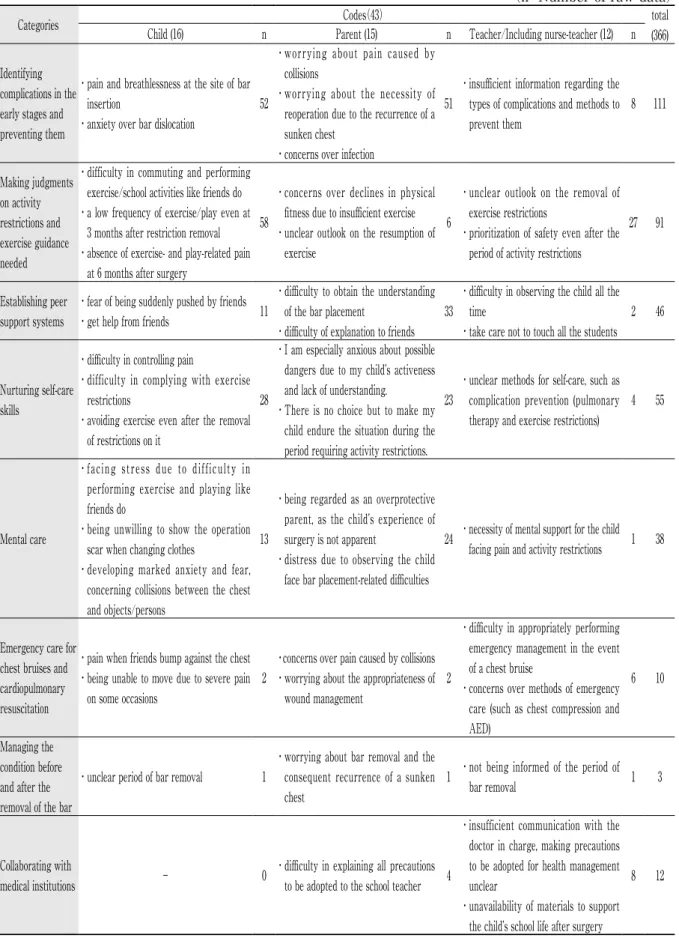43
Contents of a Program for Schools to Manage the
Health of Children Undergoing the Nuss Procedure
Tomoko NAMBA
*1, Mihoko NAKANII
*2, Momoka IWADO
*3,
Sadashige UEMURA
*4and Sho ONODERA
*1(Accepted July 14, 2018)
Key words: pectus exacavatum, Nuss procedure, QOL, school, health program
Abstract
The Nuss procedure is increasingly being performed on elementary and junior high school students with pectus exacavatum. A literature review was conducted with the aim of determining an appropriate health management program for schools to help these children. From the 16 papers identified, data representing the school life-related difficulties faced by such children and their actual situation were extracted. Through qualitative analysis, 3 categories recounting their lives before surgery were created: [identifying chest deformities in the early stages], [providing information regarding specialized medical institutions], and [reducing anxiety over surgery and returning to school]. Similarly, there were 8 categories outlining their lives after returning to school: [identifying complications in the early stages and preventing them], [making judgments on activity restrictions and exercise guidance needed], [establishing peer support systems], [nurturing self-care skills], [mental care], [emergency care for chest bruises and cardiopulmonary resuscitation], [managing the condition before and after the removal of the bar], and [collaborating with medical institutions].
*1 Department of Health and Sport Science, Faculty of Health Science and Technology, Kawasaki University of Medical Welfare, Kurashiki, 701-0193, Japan
E-Mail: t-nanba@mw.kawasaki-m.ac.jp
*2 Department of Nursing, Faculty of Medical Welfare, Kawasaki University of Medical Welfare
*3 Department of Design for Medical and Health Care, Faculty of Health and Welfare Services Administration, Kawasaki University of Medical Welfare
*4 Department of Pediatric Surgery, Kawasaki Medical School
1. Introduction
Pectus exacavatum is a congenital chest wall deformity, resulting in a sunken sternum as the primary symptom. According to school health statistics, its prevalence is approximately 1.5 per 1,000 persons1). It
is more prevalent among male children at a sex ratio of 4:1 or 3:12). The disease has been reported to lead
to various problems, including cardiopulmonary dysfunction and appearance bullying, but only a limited number of patients had previously undergone surgery in fear of possible risks. Such a situation changed when Donald Nuss established the Nuss procedure, a low-invasive surgical technique to manage the disease by placing an intrathoracic metal bar in the thasacic cauity3). It is now also being performed as the standard
surgical procedure in Japan4). Targeting children before adolescence when bone hardens with skeletal
development, the Nuss procedure is mainly used for elementary and junior high school students. After Short Report
surgery, patients are discharged in 5 to 10 days. They are forced to lead their daily lives with a metal bar placed in their body for nearly 3 years until they receive another surgery for its removal (Figure 1). Bar dislocation, pain, and infection are representative complications occurring during the postoperative period3).
Therefore, health management at school as a living environment for children plays an important role. With the aim of determining the appropriate contents of a health management program for schools to help children who undergo the Nuss procedure to lead their school lives with a sense of security, we conducted a literature review. We conducted the literature review as a survey method because we aimed to propose a program after organizing more comprehensive and important findings than can be obtained from a single questionnaire survey or interview-based survey.
Figure 1 Process from bar insertion to removal and nursing approaches
2. Methods
2.1 Web searches on research papers
To collect relevant research papers written in Japanese, web searches were conducted using an electronic database (Ichushi-Web and Citation Information by NII). The target period was between 2001, when the Nuss procedure was initially adopted in Japan, and 2017 (the day of search May 2, 2018). Web searches were initially conducted only with "pectus excavatum", and subsequently with the addition of "the Nuss procedure". The search combining these 2 keywords was narrowed by separately adding "children" as subjects of the present study, "schools" where they lead their daily lives, and "nursing" to continuously provide postoperative support for them. The number of papers identified using Ichushi-Web and CiNii Articles were 65 and 23, respectively. The values after deducting duplicated and unrelated papers were 16 and 9, respectively. All papers identified using CiNii Articles could also be found using Ichushi-Web. The entire process was performed by 2 independent reviewers.
2.2 Analytical methods
To determine appropriate contents of a health management program for schools (health management program), descriptions (raw data) outlining school life-related difficulties and methods of management/ support were extracted from the Results and Discussion sections of the papers identified. They were encoded based on similarities and categorized. The contents of support were examined from different standpoints, classifying the raw data into {children}, {parents}, and {teachers} for encoding. Analytical processes were performed by 2 researchers with experience of qualitative studies, adopting opinions from doctors, nurses, and nurse-teachers who had dealt with the disease, to ensure sufficient reliability/validity.
3. Results
3.1 Identified papers
Table 1 shows the results of the web searches explained in 2.1, while Table 2 lists the 16 papers identified through them. As for the study method, there were 9 questionnaire and 5 interview-based surveys and 2 literature/material reviews, involving children with pectus exacavatum and their parents (6), the former only (5), nurse-teachers (2), or nurses (1). Authors were limited to a collaborative research group led by Nakanii.
3.2 Health management program contents
The total number of raw data extracted using the method specified in 2.2 was 450. Encoding these, 26, 20, and 18 codes representing {children}, {parents}, and {teachers}, respectively, were obtained, which were classified into 3 and 8 categories recounting the children’s lives before surgery and after returning to school, respectively.The reason why all codes were classified and organized as "before surgery" or "after returning to school" is that disease management in school health management includes screening of diseases, instructions for consultation, and health care after treatment.In the following section, categories and codes are shown in [ ] and { }, respectively. Similarly, data regarding the children, their parents, and teachers are marked with (C), (P), and (T), respectively.
3.2.1 The children’s lives before surgery
Table 3 summarizes data regarding the children’s lives before surgery; There were 21 codes (C:10, P:5, T:6), obtained from 84 raw data representing the children’s lives before surgery and classified into 3 categories: [Identifying chest deformities in the early stages], [providing information regarding specialized medical institutions], and [Reducing anxiety over surgery and returning to school].
[Identifying chest deformities in the early stages] consisted of 10 codes, including: {difficulty in detecting chest deformities through health examinations (C)}, {chest deformities that are difficult even for parents to notice (C)}, {facing physical distress (C)}, {facing mental distress (C)}, {being afraid of the rapid progression of a sunken chest (P)}, {insufficient understanding of anxiety and difficulties due to pectus exacavatum as an unfamiliar disease (P)}, and {the probability of meeting a child who was to undergo the Nuss procedure is not low (T)}.
[Providing information regarding specialized medical institutions] consisted of 5 codes, including: {unavailability of pectus exacavatum specialists (C)}, {necessity of searching for relevant hospitals using the
Table 1 Search keyword・Number of hits
Keywords : Ichushi-WebSearch enginesCiNii
"pectus exacavatum" 462 409
"pectus exacavatum" and "the Nuss procedure" 174 143 "pectus exacavatum and the Nuss procedure"
and The following keywords : ↓ ↓
"children" 31 8
"school" 11 6
"nursing" 23 9
subtotal 65 23
exclusion criteria duplicated papers those unrelated to school life 445 113
Identified papers 16 9
duplicated papers in search engines:
Table 2 Identified papers
NO Title Author Year Publication Object extracted dataNumber of
(n =450) method target(number)
1
Supporting school life after discharging: Relationship during hospitalization-Response to children and families who undergo Nuss
Procedure-M.Nakanii,
K.Inoue et al. 2017 The Journal Child Health, 76(suppl);155 Interview Nurse(4) 7
2
Support for restoration to support the life of children living a school life with metallic bars indwelled,after the funnel breast surgery (the Nuss Procedure)
T.Namba 2016 Journal of Japanese of Child Nursing,39(10);1284-1288 documents Review of
and materials - 24
3 Explanations for teachers provided by mothers before pectus excavatum repair (the Nuss Procedure)
M.Nakanii,
T.Namba et al. 2016 The Journal Child Health, 75(3);406-412 Question paper
Child patients and their parents
(77 pairs) 46 4 Study on quality of Life of children undergoing pectus excavatum surgery (the
Nuss Procedure)
R.Kashihara,
M.Nakanii 2015 Kawasaki Journal of Medical Welfare,25(1);205-215 Question paper
Child patients and their parents
(37 pairs) 5
5
Issues awaiting solutions of the chest wall anomaly screening of school medical examinations : suggestions from the motives for consultation of primary, secondary and high school students and their feelings after undergoing the Nuss Procedure for pectus excavatum surgery
T.Namba,
M.Nakanii 2015 Kawasaki Journal of Medical Welfare,25(1);149-157 Question paper Child patients(77) 36
6 Exercise and playing of elementary school children twelve months after undergoing pectus excavatum surgery (Nuss Procedure)
M.Nakanii, T.Namba et al. 2015
Journal of the Japanese Society of Pediatric Surgeons, 51(1);162
Question
paper Child patients(42) 2
7 The school nurse heard from parents on school health management desire,after the funnel breast surgery (the Nuss Procedure)
T.Namba,
M.Nakanii 2015 The Journal Child Health, 74(suppl);115 Question paper School nurse(386) 9
8 Child and school nurse teacher feel difficulty in school life,after the funnel breast surgery (the Nuss Procedure)
T.Namba, M.Nakanii 2015
Journal of the Japanese Society of Pediatric Surgeons, 52(1);179
Question
paper School nurse(386) 11
9 Development of discharge instructions for patients who have undergone the Nuss Procedure for pectus excavatum
M.Nakanii,
T.Namba et al. 2015 Kawasaki Journal of Medical Welfare,24(2);117-128
Review of documents
and materials - 13
10 The exercise and play of children with indwelling bars six months after having undergone pectus excavatum surgery
K.Inoue, M.Nakanii
et al. 2014 Kawasaki Journal of Medical Welfare,24(1);81-87
Question
paper Child patients(44) 17
11 Exercise and playing of elementary school children three months after undergoing pectus excavatum surgery (Nuss Procedure)
M.Nakanii, T.Namba et al. 2014
Journal of Japanese Society of Nursing(Child Health Nursing), 44; 26-29
Question
paper Child patients(21) 16
12 Exercise and playing of high school children three months after undergoing pectus excavatum surgery (Nuss Procedure)
M.Nakanii,
K.Inoue et al. 2013 Japan Journal of Nursing Science,33(suppl);500 Question paper Child patients(32) 2
13 Pain caused by the pectus bar implant after the Nuss procedure for pectus excavatum among high school children
M.Nakanii, T.Namba et al. 2011
Journal of the Japanese Society of Pediatric Surgeons,
47(1);144 Interview
Child patients and their parents
(11 pairs) 69 14 Physical difficulties of children with the indwelling bar who have undergone the
Nuss procedure for pectus excavatum
M.Nakanii,
K.Takao et al. 2010 Kawasaki Journal of Medical Welfare,19(2);437-443 Interview
Child patients and their parents
(11 pairs) 64
15 An analysis of children’s anxietes after Nuss procedure on pectus excavatum and support for them
M.Nakanii, K.Takao et al. 2010
Kimura Nursing Education Promotion Foundation Nursing Research Collecting, 17;43-54
Interview and their parentsChild patients (25 pairs) 52
16 The Nuss Procedure child and mothers’ troubles placing bars inside the body after surgery
M.Nakanii,
K.Takao et al. 2009 Journal of Japanese Society of Child Health Nursing,40;15-17 Interview
Child patients and their parents
Internet as the only measure (C)}, {difficulty in choosing the most appropriate hospital (P)}, and {difficulty in selecting a hospital to refer the child to from multiple choices (T)}.
Lastly, [Reducing anxiety over surgery and returning to school] consisted of 7 codes, including: {deconditioning due to preoperative anxiety (C)}, {being afraid of surgery (C)}, {anxiety over the uncertainty of school life after surgery (C)}, {difficulty in agreeing on surgery for the child (P)}, {providing heart care and place of residence for anxiety before surgery (T)}, and {providing information on surgery (T)}.
Table 3 Contents of a program for schools to manage the health of children’s lives before surgery
(n=Number of raw data) Categories Child (10) n Parent (5) Codes(21) n Teacher/Including nurse-teacher (6) n total(84)
Identifying chest deformities in the early stages
・ difficulty in detecting chest deformities through health examinations
・ chest deformities that are difficult even for parents to notice
・ unwilling to attend swimming classes due to a sunken chest
・ facing physical distress (such as declines in cardiopulmonary function, breathlessness, and chest pain)
・ facing mental distress (such as negative body images and bullying)
13
・ being afraid of the rapid progression of a sunken chest ・ insufficient understanding of anxiety and difficulties due to pectus exacavatum as an unfamiliar disease
2
・ the probability of meeting a child who was to undergoing the Nuss procedure is not low
・ notification of surgery during summer vacations for the child who has been diagnosed with suspected disease progression through a health examination and consulted his family doctor
11 26 Providing information regarding specialized medical institutions
・ unavailability of pectus exacavatum specialists
・ necessity of searching for relevant hospitals using the Internet as the only measure
2 ・ difficulty in choosing the most appropriate hospital 2
・ difficulty in selecting a hospital to refer the child to from multiple choices ・ understanding of medical expenses
subsidies is poor 5 9 Reducing anxiety over surgery and returning to school
・ deconditioning due to preoperative anxiety
・being afraid of surgery
・ anxiety over the uncertainty of school life after surgery
25
・ difficulty in agreeing on surgery for the child ・ anxiety whether surgery is
safe or not
16
・ provide heart care and place of residence for anxiety before surgery ・provide information on surgery
8 49
3.2.2 The children’s lives after returning to school
Table 4 summarizes data regarding the children’s lives after returning to school; There were 43 codes(C: 16, P: 15, T: 12), obtained from 366 raw data representing the children’s lives before surgery and classified into 8 categories: [Identifying complications in the early stages and preventing them], [Making judgments on activity restrictions and exercise guidance needed], [Establishing peer support systems], [Nurturing self-care skills], [Mental self-care], [Emergency self-care for chest bruises and cardiopulmonary resuscitation], [Managing the condition before and after the removal of the bar], and [Collaborating with medical institutions].
[Identifying complications in the early stages and preventing them] consists of 6 codes, including: {pain and breathlessness at the site of bar insertion (C)}, {anxiety over bar dislocation (C)}, {worrying about pain caused by collisions (P)}, and {worrying about the necessity of reoperation due to the recurrence of a sunken chest (P)}, and {insufficient information regarding the types of complications and methods to prevent them (T)}. [Making judgments on activity restrictions and exercise guidance needed] consisted of 7 codes, including: {difficulty in commuting and performing exercise/school activities like friends do (C)}, {a low frequency of exercise/play even at 3 months after restriction removal (C)}, {concerns over declines in physical fitness due to insufficient exercise (P)}, {unclear outlook on the resumption of exercise (P)}, {unclear outlook on the removal of exercise restrictions (T)}, and {prioritization of safety even after the period of activity restrictions (T)}.
Table 4 Contents of a program for schools to manage the health of children’s lives after returning to school
(n=Number of raw data)
Categories Codes(43) total
(366) Child (16) n Parent (15) n Teacher/Including nurse-teacher (12) n
Identifying complications in the early stages and preventing them
・ pain and breathlessness at the site of bar insertion
・anxiety over bar dislocation
52
・ worrying about pain caused by collisions
・ worrying about the necessity of reoperation due to the recurrence of a sunken chest
・concerns over infection
51
・ insufficient information regarding the types of complications and methods to prevent them 8 111 Making judgments on activity restrictions and exercise guidance needed
・ difficulty in commuting and performing exercise/school activities like friends do ・ a low frequency of exercise/play even at
3 months after restriction removal ・ absence of exercise- and play-related pain
at 6 months after surgery
58
・ concerns over declines in physical fitness due to insufficient exercise ・ unclear outlook on the resumption of
exercise
6
・ unclear outlook on the removal of exercise restrictions
・ prioritization of safety even after the period of activity restrictions
27 91
Establishing peer support systems
・fear of being suddenly pushed by friends ・get help from friends 11
・ difficulty to obtain the understanding of the bar placement
・difficulty of explanation to friends 33
・ difficulty in observing the child all the time
・take care not to touch all the students 2 46
Nurturing self-care skills
・difficulty in controlling pain
・ difficulty in complying with exercise restrictions
・ avoiding exercise even after the removal of restrictions on it
28
・ I am especially anxious about possible dangers due to my child’s activeness and lack of understanding.
・ There is no choice but to make my child endure the situation during the period requiring activity restrictions.
23
・ unclear methods for self-care, such as complication prevention (pulmonary therapy and exercise restrictions)
4 55
Mental care
・ facing stress due to difficulty in performing exercise and playing like friends do
・ being unwilling to show the operation scar when changing clothes
・ developing marked anxiety and fear, concerning collisions between the chest and objects/persons
13
・ being regarded as an overprotective parent, as the child’s experience of surgery is not apparent
・ distress due to observing the child face bar placement-related difficulties
24 ・ necessity of mental support for the child facing pain and activity restrictions 1 38
Emergency care for chest bruises and cardiopulmonary resuscitation
・pain when friends bump against the chest ・ being unable to move due to severe pain
on some occasions
2
・concerns over pain caused by collisions ・ worrying about the appropriateness of
wound management
2
・ difficulty in appropriately performing emergency management in the event of a chest bruise
・ concerns over methods of emergency care (such as chest compression and AED)
6 10
Managing the condition before and after the removal of the bar
・unclear period of bar removal 1
・ worrying about bar removal and the consequent recurrence of a sunken chest
1 ・ not being informed of the period of
bar removal 1 3
Collaborating with
medical institutions - 0
・ difficulty in explaining all precautions to be adopted to the school teacher 4
・ insufficient communication with the doctor in charge, making precautions to be adopted for health management unclear
・ unavailability of materials to support the child’s school life after surgery
[Establishing peer support systems] consisted of 6 codes, including: {fear of being suddenly pushed by friends (C)}, {get help from friends (C)}, {difficulty to obtain the understanding of the bar placement (P)}, {difficulty of explanation to friends (P)}, and {difficulty in observing the child all the time (T)}.
[Nurturing self-care skills] consisted of 6 codes, including: {difficulty in controlling pain (C)}, {difficulty in complying with exercise restrictions (C)}, {there is no choice but to make my child endure the situation during the period requiring activity restrictions. (P)}, and {unclear methods for self-care, such as complication prevention (pulmonary therapy and exercise restrictions) (T)}.
[Mental care] consisted of 6 codes, including: {facing stress due to difficulty in performing exercise and playing like friends do (C)}, {being unwilling to show the operation scar when changing clothes (C)}, {being regarded as an overprotective parent, as the child’s experience of surgery is not apparent (P)}, and {necessity of mental support for the child facing pain and activity restrictions (T)}.
[Emergency care for chest bruises and cardiopulmonary resuscitation] consisted of 6 codes, including: {pain when friends bump against the chest (C)}, {being unable to move due to severe pain on some occasions (C)}, {worrying about the appropriateness of wound management (P)}, {difficulty in appropriately performing emergency management in the event of a chest bruise (T)}, and {concerns over methods of emergency care (such as chest compression and AED) (T)}.
[Managing the condition before and after the removal of the bar] consisted of 3 codes, including: {unclear period of bar removal (C)}, {worrying about bar removal and the consequent recurrence of a sunken chest (P)}, and {not being informed of the period of bar removal (T)}.
Lastly, [collaborating with medical institutions] consisted of 3 codes, including: {difficulty in explaining all precautions to be adopted to the school teacher (P)}, {insufficient communication with the doctor in charge, making precautions to be adopted for health management unclear (T)}, and {unavailability of materials to support the child’s school life after surgery (T)}.
4. Discussion
Through analysis to determine appropriate contents of a health management program for schools to help children who undergo the Nuss procedure, 3 and 8 categories representing such children’s lives before surgery and after returning to school, respectively, were created. The following section discusses the applicability of these categories as contents of a health management program that can be shared and used by nurse-teachers and all other supporters engaged in school health management:
4.1 The children’s lives before surgery
The 3 categories, [identifying chest deformities in the early stages], [providing information regarding specialized medical institutions], and [reducing anxiety over surgery and returning to school] represented the preoperative lives of children who undergo the Nuss procedure.
In 80% of all cases of pectus exacavatum, the period of onset is infancy. However, it is rare for the disease to cure naturally, and deformities tend to progress with growth, causing both mental and physical distress5).
Patients with pectus exacavatum have been reported to be characterized by their negative body images which do not easily improve even after the surgical removal of deformities if once established6). Therefore,
approaches for early treatment, such as [identifying chest deformities in the early stages], may be important. On the other hand, as chest deformities are dealt with by multiple departments, including those specializing in pediatric, plastic, or cardiac surgery, it is difficult for patients and their parents to access treatment, as explained by {difficulty in choosing the most appropriate hospital}. This also leads to the necessity of [providing information regarding specialized medical institutions] after the identification of deformities. Children examined by specialists and diagnosed with the disease requiring surgery face dilemmas, such as wishing to cure the disease while {being afraid of surgery} and developing {anxiety over the uncertainty of school life after surgery (C)}7). At this point, support approaches, such as [reducing anxiety over surgery and
children accept surgery and actively participate in hospitalization/treatment.
4.2 The children’s lives after returning to school
The recounting of children’s lives after returning to school are classified into 8 categories. These categories are described as [identifying complications in the early stages and preventing them] [making judgments on activity restrictions and exercise guidance needed], [establishing peer support systems], and [nurturing self-care skills] and mental and physical care [emergency care for chest bruises and cardiopulmonary resuscitation], [mental care], [managing the condition before and after the removal of the bar], and [collaborating with medical institutions].
Complications require the most careful attention after surgery. Bar dislocation, pain, and infection are representative complications occurring after the Nuss procedure. At school, [identifying complications in the early stages and preventing them] is a particularly important measure against bar dislocation and pain. To prevent these, some exercise restrictions are frequently needed until 4 months after the Nuss procedure6).
However, recent studies have revealed that patients tend to avoid exercise even when it is performable due to fear and muscle weakness8). To resolve such a situation, the necessity of encouraging motor activities
if they do not involve pain during discharge guidance or when explaining precautions to be adopted after surgery is being advocated9). Accordingly, schools are expected to play a role in [making judgments on
activity restrictions and exercise guidance needed]. At school patients may suffer from chest pain and bar dislocation due to collisions with friends. As they may also seek help from their friends after returning to school, approaches, such as [establishing peer support systems], are needed. In this case, the term "peer support" refers to support activities performed by other students of the same school or classmates10). If
friends who are close to patients become their supporters, and help them lead a safe life, favorable care environments may be created in schools and classes11), consequently contributing to complication prevention.
At the same time, [nurturing self-care skills] consisting of {difficulty in controlling pain} and {difficulty in complying with exercise restrictions} is important for patients to acquire skills to prevent complications independently. This may also nurture their autonomy to control their own health management behaviors according to their physical conditions, rather than simply being supported by teachers and friends, with passive attitudes.
Mental and physical care are represented by [mental care] to reduce {stress due to difficulty in performing exercise and playing like friends do} and [emergency care for chest bruises and cardiopulmonary resuscitation]. Stress associated with bar placement and limited daily activities after surgery markedly affects active children during the growth period. As they also develop anxiety and fear, concerning collisions between their chest and objects/persons, [mental care], including stress management, may be an important approach. The necessity of [emergency care for chest bruises and cardiopulmonary resuscitation] should also be shared among all teachers, as this influences patients’ lives. When performing chest compression as part of cardiopulmonary resuscitation, it is necessary to compress the chest relatively strongly from above the metal bar, while AED should be performed, with electrode pads placed on the chest and back to avoid contact with the bar12). In addition to these categories, [managing the condition
before and after the removal of the bar] that has been placed for approximately 3 years was also extracted. The Nuss procedure is completed by receiving surgery for bar removal. As bar removal itself is rarely problematic, the subsequent recurrence of a sunken chest tends to be disregarded, but this is a problem that is yet to be resolved13). Considering that children who undergo initial surgery around the period of
school enrolment are particularly subject to such a condition6), it may also be necessary to clarify the
periods of surgery and bar removal, as well as the subsequent course.
[Collaborating with medical institutions] was another category extracted. By performing the above-mentioned approaches: [making judgments on activity restrictions and exercise guidance needed], [emergency care for chest bruises and cardiopulmonary resuscitation], and [managing the condition before and after the removal of the bar] through such collaboration, it is possible to acquire specialized findings
as a basis for health management; thus, this may be an effective approach to support postoperative complication prevention and mental/physical care.
5. Future challenges
This study clarified appropriate contents of a health management program, focusing on children’s lives before undergoing the Nuss procedure and after returning to school. These contents may be widely usable as a means of common recognition among those engaged in school health services for the early identification of chest deformities, specialized consultation service use, and postoperative health management. In the future, a support book with detailed explanation and diagrams will be created for each program and distributed to related institutions.
Conflict of interest
The authors have declared that they have no conflict of interest. Acknowledgements
This study was supported by JSPS KAKENHI Grant Number 16K12188, FY 2016-2018, and presented at the 18th CWIG Annual Meeting in Florence, Italy.
References
1. Ministry of Education, Culture, Sports, Science and Technology : Annual report of school health statistics research. https://www.e-stat.go.jp/stat-search/files?page=1&layout=datalist&toukei=00400002&tstat=00 0001011648&cycle=0&tclass1=000001021419&tclass2=000001021420&second2=1, 2006. (March 9, 2018) (In Japanese, translated by the author of this article)
2. Molik KA, Engum SA, Rescorla FJ, West KW, Scherer LR and Grosfeld JL : Pectus excavatum repair: Experience with standard and minimal invasive techniques. Journal of Pediatric Surgery, 36(2), 324-328, 2001.
3. Nuss D, Kelly RE Jr, Croitoru DP and Katz ME : A 10-year review of a minimally invasive technique for the correction of pectus excavatum. Journal of Pediatric Surgery, 33(4), 545-552, 1998.
4. Uemura S, Yoshida A, Yamamoto M and Kuyama H : Knowledge of the latest fpectus excavatum. Japanese Journal of Pediatric Surgery, 48(8), 765-768, 2016. (In Japanese)
5. Uemura S : Surgery adaptation and treatment for pectus excavatum. Japanese Journal of Pediatrics, 69(11), 28-34, 2016. (In Japanese, translated by the author of this article)
6. Nagasao T and Noguchi M : Treatment for pectus excavatum. Kokuseido Shuppan, Tokyo, 2016. (In Japanese) 7. Namba T, Nakanii M, Kashihara R and Uemura S : Issues awaiting solutions of the chest wall anomaly screening of school medical examinations: Suggestions from the motives for consultation of primary, secondary and high school students and their feelings after undergoing the Nuss Procedure for pectus excavatum surgery. Kawasaki Medical Welfare Journal, 25(1), 149-157, 2015. (In Japanese with English abstract)
8. Nakanii M, Ishimoto T, Namba T, Kawasaki K, Takao K, Kashihara R, Akazawa M, Moriyasu A, Yoshida A and Uemura S : Exercise and playing of elementary school children three months after undergoing pectus excavatum surgery (Nuss procedure). Journal of Japanese Society of Nursing: Child Health Nursing,
44(1), 26-29, 2014. (In Japanese, translated by the author of this article)
9. Nakanii M, Namba T, Inoue K and Ono A : Supporting school life after discharging relationship during hospitalization: Response to children and families who undergo Nuss procedure. The Journal Child Health,
76(suppl), 155, 2017. (In Japanese, translated by the author of this article)
10. Nagai S, Matuo N and Arai K : A trial of peer support program for freshmen at university. Bulletin of Tokyo Gakugei University. Series I, Science of Education, 55(1), 81-91, 2004. (In Japanese with English abstract) 11. Naylor P and Cowie H : The effectiveness of peer support systems in challenging school bullying: The
perspectives and experiences of teachers and pupils. Journal of Adolescence, 22(1), 467-479, 1999.
12. Namba T : Support for restoration to support the life of children living a school life with metallic bars indwelled, after the funnel breast surgery (the Nuss Procedure). The Japanese Journal of Child Nursing, Monthly, 39(10), 1284-1288, 2016. (In Japanese, translated by the author of this article)
13. Yamamoto M, Uemura S, Yoshida A and Kuyama H : Long-term elapsed of patients with pectus excavatum after the Nuss procedure. Japanese Journal of Pediatric Surgery, 48(8), 765-768, 2016. (In Japanese, translated by the author of this article)
